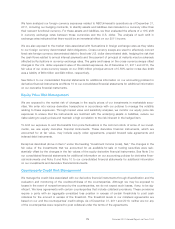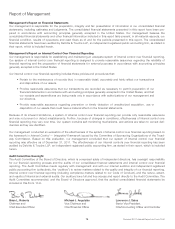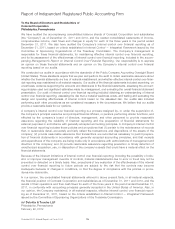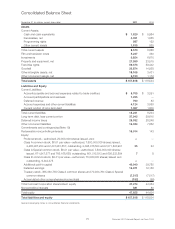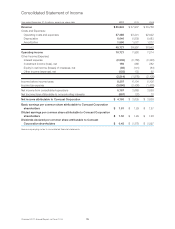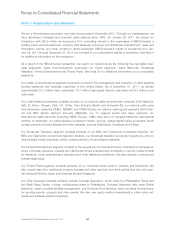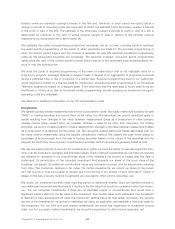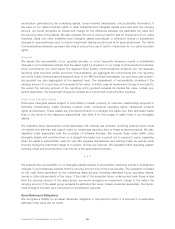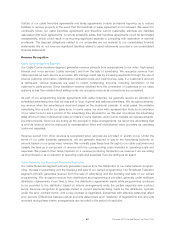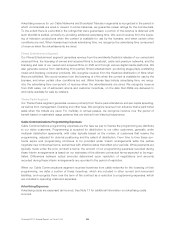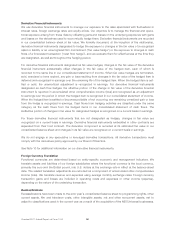Comcast 2011 Annual Report Download - page 85
Download and view the complete annual report
Please find page 85 of the 2011 Comcast annual report below. You can navigate through the pages in the report by either clicking on the pages listed below, or by using the keyword search tool below to find specific information within the annual report.
Note 2: Summary of Significant Accounting Policies
Basis of Consolidation
The accompanying consolidated financial statements include (i) all of our accounts, (ii) all entities in which we
have a controlling voting interest (“subsidiaries”) and (iii) variable interest entities (“VIEs”) required to be con-
solidated in accordance with generally accepted accounting principles in the United States (“GAAP”). We
have eliminated intercompany accounts and transactions among consolidated entities.
Use of Estimates
We prepare our consolidated financial statements in accordance with GAAP, which requires us to make esti-
mates and assumptions that affect the reported amounts and disclosures. Actual results could differ from
those estimates. Estimates are used when accounting for various items, including the fair value of acquisition-
related assets and liabilities, allowances for doubtful accounts, amortization of owned and acquired
programming, impairment of capitalized film and television costs, participation and residual accruals, invest-
ments, derivative financial instruments, asset impairments, nonmonetary transactions, pensions and other
postretirement benefits, revenue recognition, estimates of DVD and Blu-ray discs (together, “DVDs”) returns
and customer incentives, depreciation and amortization, income taxes, legal contingencies, and other con-
tingent liabilities. See Note 11 for our discussion on fair value measurements.
Cash Equivalents
The carrying amounts of our cash equivalents approximate their fair value. Our cash equivalents consist pri-
marily of money market funds and U.S. government obligations, as well as commercial paper and certificates
of deposit with maturities of less than three months when purchased.
Film and Television Costs
We capitalize film and television production costs, including direct costs, production overhead, print costs,
development costs and interest. We amortize capitalized film and television production costs, including
acquired libraries, and accrue costs associated with participation and residual payments to operating costs
and expenses. We record the amortization and the accrued costs using the ratio of the current period’s
actual revenue to the estimated total remaining gross revenue from all sources, which is referred to as ulti-
mate revenue. Estimates of total revenue and total costs are based on anticipated release patterns, public
acceptance and historical results for similar productions. Unamortized film and television costs, including
acquired film and television libraries, are stated at the lower of unamortized cost or fair value. We do not capi-
talize costs related to the exhibition, licensing or sale of a film or television production, which are primarily
costs associated with the marketing and distribution of film and television programming.
In determining the estimated lives and method of amortization of acquired film and television libraries, we
generally use the method and the life that most closely follow the undiscounted cash flows over the estimated
life of the asset.
Upon the occurrence of an event or change in circumstance that may indicate that the fair value of a film is
less than its unamortized costs, we determine the fair value of the film and record an impairment charge for
the amount by which the unamortized capitalized costs exceed the film’s fair value.
We enter into arrangements with third parties to jointly finance and distribute certain of our film productions.
These arrangements, which are referred to as cofinancing arrangements, can take various forms. In most
cases, the form of the arrangement involves the grant of an economic interest in a film to a third-party invest-
or. The number of investors and the terms of these arrangements can also vary, although in most cases an
investor assumes full risk for the portion of the film acquired in these arrangements. We account for our pro-
ceeds under these arrangements as a reduction to our capitalized film costs. In these arrangements, the
83 Comcast 2011 Annual Report on Form 10-K


